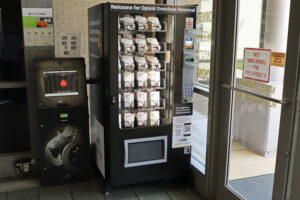In July 2025, swift coordination between law enforcement and public health partners enabled Baltimore City to respond rapidly to a suspected mass casualty overdose event. The Maryland Overdose Response Strategy (ORS) Drug Intelligence Officer (DIO) was alerted by the Baltimore Police Department (BPD) to a suspected overdose event at the intersection of Pennsylvania Avenue and North Avenue. The MD DIO and a BPD Detective responded to the scene while the MD DIO also notified the Maryland Public Health Analyst (PHA), who quickly engaged the public health entities involved with overdose response in Baltimore City–ensuring a unified, multi-agency response.
At the scene, a BPD detective collected suspected controlled substance packaging from an overdose victim. The MD DIO and BPD detective then transported the sample to the Washington/Baltimore HIDTA office to conduct presumptive testing using the investigative support center (ISC)’s MX-908 device, which identified the presence of acetylfentanyl, an opioid analgesic drug that is an analog of fentanyl. Results were immediately shared with the BPD Major to guide law enforcement efforts, and the MD ORS team relayed the information to Baltimore City public health partners to inform ongoing prevention and response measures. The Maryland Overdose and Drug Awareness Coordinators were also notified, and the incident details were disseminated through the state’s communication network. The MD DIO provided real-time updates to promote situational awareness across agencies, while the MD PHA alerted surrounding ORS teams and two working groups that focus on overdose prevention along the I-81 and I-95 interstate highway corridors.
Within four to five hours, agencies identified the likely substance and mobilized a coordinated response–out of the 27 individuals who were hospitalized during this mass overdose event there were no fatalities. This demonstrates how rapid communication and cross-sector collaboration can protect lives and strengthen overdose prevention in Baltimore City.

In July 2025, swift coordination between law enforcement and public health partners enabled Baltimore City to respond rapidly to a suspected mass casualty overdose event.

The New York Overdose Response Strategy (ORS) team developed and piloted a Mock Overdose Fatality Review (OFR) Toolkit—a first-of-its-kind resource designed to help communities prepare

In a first for Georgia, the state’s Overdose Response Strategy (ORS) team helped launch a new initiative with the installation of a naloxone vending machine

Over Memorial Day weekend 2025, Connecticut public health and safety partners launched a rapid, coordinated response to a spike in overdoses in New Haven County.

Predictive modeling has emerged as one of West Virginia’s most effective strategies for improving overdose prevention. From January 2022 through December 2024, the West Virginia

After meeting the End Overdose CEO, Theo Krzywicki, at the 2024 Overdose Response Strategy (ORS) conference in Dallas, the Nevada ORS team recognized an opportunity